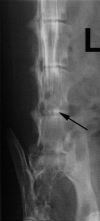Spontaneous lumbar intervertebral disc protrusion in cats: literature review and case presentations
- PMID: 11716620
- PMCID: PMC10829134
- DOI: 10.1053/jfms.2000.0098
Spontaneous lumbar intervertebral disc protrusion in cats: literature review and case presentations
Abstract
Reports on intervertebral disc disease in cats are rare in the veterinary literature. It has been postulated that intervertebral disc protrusion is a frequent finding during necropsy in cats, without having any clinical relevance (King and Smith 1958, King & Smith 1960a, King & Smith 1960b). However, a total of six cases with disc protrusions and clinically significant neurological deficits have been reported over the past decade. (Heavner 1971, Seim & Nafe 1981, Gilmore 1983, Littlewood et al 1984, Sparkes & Skerry 1990, Bagley et al 1995). As in dogs, there are also two types of intervertebral disc disease in cats: Hansen's type I (extrusion), and type II (herniation). Cervical spinal cord involvement was more commonly recognised in cats than the lumbar or the thoraco lumbar area. Cats over 15 years were mainly affected (King & Smith 1958, King & Smith 1960a, King & Smith 1960b). We describe two cats with lumbar intervertebral disc protrusions. Emphasis is placed on differential diagnoses, treatment and follow-up.
Copyright 2000 European Society of Feline Medicine.
Figures




Similar articles
-
Intervertebral disc extrusion in six cats.J Feline Med Surg. 2001 Sep;3(3):161-8. doi: 10.1053/jfms.2001.0131. J Feline Med Surg. 2001. PMID: 11876633 Free PMC article.
-
What is your diagnosis? A case of intervertebral disc protrusion in a cat: lymphosarcoma.J Small Anim Pract. 2006 Feb;47(2):104-6. doi: 10.1111/j.1748-5827.2006.00021.x. J Small Anim Pract. 2006. PMID: 16438699 No abstract available.
-
Acute non-ambulatory tetraparesis attributable to cranial cervical intervertebral disc disease in a cat.J Feline Med Surg. 2007 Dec;9(6):494-8. doi: 10.1016/j.jfms.2007.03.009. Epub 2007 Jun 8. J Feline Med Surg. 2007. PMID: 17560823 Free PMC article.
-
Roentgen signs of the spine.Vet Clin North Am. 1974 Nov;4(4):647-61. doi: 10.1016/s0091-0279(74)50078-4. Vet Clin North Am. 1974. PMID: 4612941 Review. No abstract available.
-
Herniated intervertebral disc without pain.J Okla State Med Assoc. 1997 May-Jun;90(5):185-90. J Okla State Med Assoc. 1997. PMID: 9203767 Review.
Cited by
-
Feline physiotherapy and rehabilitation: 2. clinical application.J Feline Med Surg. 2012 Sep;14(9):633-45. doi: 10.1177/1098612X12458210. J Feline Med Surg. 2012. PMID: 22918846 Free PMC article. Review.
-
Acupuncture treatment for feline multifocal intervertebral disc disease.J Feline Med Surg. 2009 Aug;11(8):706-10. doi: 10.1016/j.jfms.2008.11.013. Epub 2009 Jan 31. J Feline Med Surg. 2009. PMID: 19186087 Free PMC article.
-
Spinal cord compression in a cat due to vertebral angiomatosis.J Feline Med Surg. 2010 Feb;12(2):179-82. doi: 10.1016/j.jfms.2009.10.003. Epub 2009 Nov 20. J Feline Med Surg. 2010. PMID: 19932041 Free PMC article.
-
Prevalence and breed predisposition for thoracolumbar intervertebral disc disease in cats.J Feline Med Surg. 2017 Apr;19(4):419-423. doi: 10.1177/1098612X16630358. Epub 2016 Jul 9. J Feline Med Surg. 2017. PMID: 26868632 Free PMC article.
-
Acute intervertebral disc extrusion in a cat: clinical and MRI findings.J Feline Med Surg. 2002 Mar;4(1):65-8. doi: 10.1053/jfms.2001.0150. J Feline Med Surg. 2002. PMID: 11869056 Free PMC article.
References
-
- Bagley RS, Tucker RL, Moore MP, Harrington ML. (1995) Intervertebral disk extrusion in a cat. Veterinary Radiology and Ultrasound 36, 380–382.
-
- Bojrab MJ. (1993) Disease Mechanisms in Small Animal Surgery. 2nd edn. Philadelphia: Lea & Febiger, pp 1140–1157.
-
- Gilmore DR. (1983) Extrusion of a feline intervertebral disk. Veterinary Medicine for the Small Animal Clinician 78, 207–209.
-
- de Lahunta A. (1983) de Lahunta's Veterinary Neuroanatomy and Clinical Neurology, (2nd edn). Philadelphia, WB Saunders, pp 169–200.
-
- Heavner JE. (1971) Intervertebral disc syndrome in the cat. Journal of the American Veterinary Medical Association 159, 425–427. - PubMed
Publication types
MeSH terms
LinkOut - more resources
Full Text Sources
Medical
Research Materials
Miscellaneous

